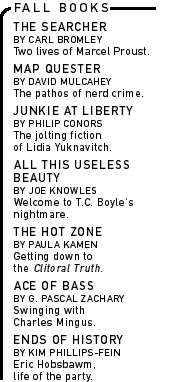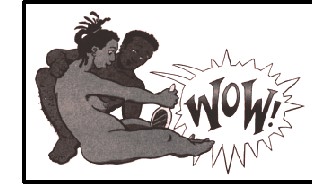
|

|

|

|
| |
|
|
|
The Clitoral Truth: The Secret World at Your Fingertips
For centuries, women's sexual anatomy has been described as "mysterious," "unknowable" and "perplexing"--harboring more riddles than the Sphinx, the pyramids of ancient Egypt and the rock formations of Stonehenge combined. Not really, counters author Rebecca Chalker. It's really quite easy to figure out. You just have to know where to look. In her latest book, The Clitoral Truth, this longtime women's health activist seeks to
Her main contribution to the current literature on the subject is to describe the clitoris as a system of 18 distinct and interrelated structures, with each part having a counterpart on the male body (as documented earlier in a 1991 book she edited for the Federation of Feminist Women's Health Centers). Not all of these 18 parts of the clitoris are visible, but all of them can be felt, especially during sexual arousal. This includes an elaborate network of pelvic muscles, two-types of erectile tissue and a long wishbone-shaped shaft. Overall, she seeks to restore the view of the penis and clitoris as equal counterparts, which she says existed for more than 2,500 years--until philosophers and other "experts" in the 18th century portrayed the clitoris (and women's sexual response as a whole) as inferior to that of men. Then she relates the cultural tale of how all this information has been lost or covered up through the years, exploring the long-disputed subject of female ejaculation and reporting on ways women are expanding their sexual repertoires. For a lot of feminists (along with any casual reader of Cosmo, for that matter), this hardly qualifies as breaking news. Throughout history, the clitoris--and its great potential--have been lost and found over and over again. The clitoris was, after all, a major source of feminist consciousness-raising in the '70s. In spotlighting the clitoris, women's liberationists exposed oppressive social untruths about female biology and countered the old Freudian party line of the vagina as the exclusive natural source of a true "mature" woman's pleasure (and the clitoris as a "girlish phase"). As Chalker herself describes in her colorful second chapter, "The Case of the Missing Clitoris," back in 1966 sex researchers Masters and Johnson proclaimed that female and male genitals "are equivalent structures that function in similar ways to produce sexual pleasure and orgasm." The findings of these and other sex researchers were later popularized by feminists like Barbara Seaman, Lonnie Barbach and Shere Hite, not to mention the Boston Women's Health Book Collective's juggernaut dorm-floor staple, Our Bodies, Ourselves. More recently, academics Marcia and Lisa Douglass documented the clitoris' potential in Are We Having Fun Yet? The Intelligent Woman's Guide to Sex, and, with a confessional e-zine style and breezy literary verve, Seattle writer Inga Muscio put forth the young feminist cult-favorite Cunt: A Declaration of Independence. Yet Chalker's book stands out as a highly accessible and updated report on the work of the women's health movement for a new popular audience. The book is indeed marketed to a non-academic, not necessarily feminist readership, with its straightforward and clear writing, cute compact size and sexy cover--the book's subtitle descends word by word from a naked woman's navel to her nether regions. But rather than "selling out," this packaging holds true to the most basic ideals of the women's health movement, a separate branch of feminism--with which Chalker has long been associated--that emerged in the '60s. While bringing biology down to earth, the women's health movement demystifies traditional male authorities, like doctors and psychologists, who have always prescribed and proscribed just what women should want. Meanwhile, these activists have sought to raise political consciousness, bringing to light how cultural views of women alter their most personal experiences. It is this work that provides the foundation of The Clitoral Truth. Some of Chalker's main sources are the gurus of the '70s women's health movement, such as spunky masturbation advocate Betty Dodson, author of the classic Sex for One and videos by feminist porn star Annie Sprinkle. Chalker also makes colorful use of manuals published by Good Vibrations, the feminist worker-owned cooperative sex shop in San Francisco. This adds personality to the book, as in a section on vibrators where Chalker describes the conventional woman's "romantic fantasy of Prince Charming leaning over and kissing [her] awake, and the two of them living happily ever after." She then quotes Dodson's retort: "In my version, Sleeping Beauty wakes herself up with a 60 hertz electric massager vibrating at 5,000 revolutions per minute." Like the women's health movement pioneers, Chalker always includes voices of "non-experts" and documents cases of "self-exploration." The last part of this book could be called "The Clitoral Monologues," excerpting women's explicit first-hand accounts of attending '70s-style, literally hands-on workshops for improving orgasms, increasing body acceptance and mastering tantric sex. In every discussion of female sexual response, without being heavy-handed Chalker brings the subject back to politics. For example, in a sidebar about her own difficult teen-age quest for sexual information at the Florida State University library in the '50s, she also criticizes current right-wing campaigns for abstinence-only and sex-negative education, analyzing their long-range implications for the health of the nation's youth. Chalker is happily and relentlessly inclusive with descriptions and illustrations, picturing heterosexuals, bisexuals and lesbians of many races. More mainstream readers, unaccustomed to the eager anti-prudery spirit of this movement, also may be startled by the jaunty casualness of the language used to describe historically taboo acts. But despite its grounding in the '70s, the book isn't stuck in the Carter administration, and reflects young feminists' desire to explore all aspects of sex, even the politically incorrect. Praising the work of anti-censorship feminists to create their own woman-centered "postporn erotica" that encourages sexual fantasies (an ingredient to much-valued masturbation), she recognizes movements to expand erotic boundaries. "Many young women are refusing to be bound by rigid gender roles and some are even identifying themselves as bisexual rather than exclusively heterosexual or lesbian," she writes. She adds that "S/M games" play with power dynamics in relationships in healthy ways to vary sex. Despite some more adventurous passages, the findings in this book
will not be news to many feminist activists and other readers. If
you have a subscription to the Good Vibrations catalog, own at least
one Susie Bright book or have read the lesbian sex magazine On
Our Backs, this book may be too basic for you. And younger or
more mainstream readers might be put off by some ebullient or earnest
'70s phrasings like "the rich banquet of sexuality." But, in a mass
market that systematically feeds women a stream of sex advice stripped
of nearly all feminist politics--from MTV's Dr. Drew to Glamour--Chalker's
book stands out with its integrity, its feminism over focus groups.
The Clitoral Truth truly reflects the author's impressive
commitment to guide readers to a level of exploration that can only
be described as "The Joy of Feminist Sex." Paula Kamen is the author of Her Way: Young Women Remake the Sexual Revolution (forthcoming from New York University Press) and the play Jane: Abortion and the Underground.
|


